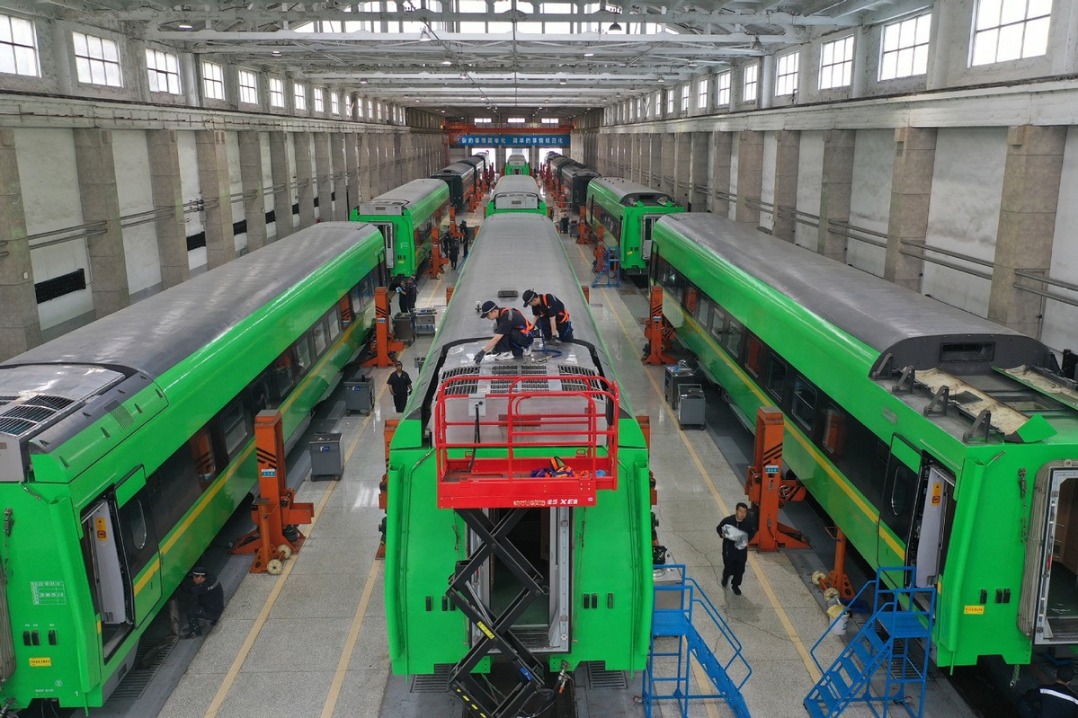Convenience stores feeding more

Street vendors losing business to ready-to-eat foods
At about noon one weekday in Maizidian, a bustling business area in Beijing, office workers file continuously in and out of a convenience store.
Nearly all emerge with packaged meals and drinks before hurrying back to work.
The store, run by the Bianlifeng chain, sells 800 to 1,000 packaged meals, usually consisting of rice and several smaller dishes, at lunchtime every workday. About 80 percent of the customers are white-collar workers, according to Bianlifeng, which translates as "convenient bee".
Reasonable prices, convenience and quality of ready-to-eat meals have transformed convenience stores into virtual kitchens for many urban workers, according to industry insiders.
Zhang Hui, 32, a manager at a foreign company in Shanghai, depends on these stores for most of her meals. She spends less than 10 yuan ($1.45) on breakfast, including steamed stuffed buns, fried bread sticks, congee or soybean milk, and about 20 yuan on packaged meals or a bowl of oden, a Japanese dish, for lunch and dinner each day.
"When I'm in a hurry, or when I have to eat alone, I will choose ready-to-eat foods in convenience stores, which are fast, make buying easy and they save me from feeling awkward about eating alone in a restaurant," Zhang said. "Moreover, the taste of such foods is acceptable."
The China Chain Store & Franchise Association said that last year, the sales volume of the country's top 100 convenience store companies rose by 21.1 percent year-on-year, with an 18 percent increase in store numbers, the fastest in the retail sector.
China has some 122,000 convenience stores, mainly located in first-and second-tier cities. Last year, 38 percent of convenience store chains said that more than 20 percent of their daily sales came from ready-to-eat food. In 2017, only 29 percent of these chains recorded such a proportion of sales.
Andy Zhang, senior project manager at global consultancy Roland Berger, said that convenience stores in China are increasing their proportion of ready-to-eat food to meet increasing market demand. Some leading Japanese chains in China report that 35 to 40 percent of their sales are ready-to-eat food.
"With economic development, the pace of life in first-and second-tier cities has quickened, and people don't have as much time to cook as before," Zhang said.
With more disposable income, people are increasingly willing to spend on convenience, and now have a higher regard for the environment and food safety.
Ready-to-eat food at convenience stores has replaced that offered by street vendors, which is often viewed as being unhealthy or unhygienic. For example, many people who used to buy breakfast from such vendors have now turned to convenience stores, Zhang said.
Moreover, people used to have big families, and cooking was economical for them, he added.
"But modern families are becoming smaller, with each one now comprising about 3.1 people on average, who prefer casual and small meals. Ready-to-eat food in convenience stores satisfies these needs, especially for a large number of young single people."
Zhang said about half of the customers at convenience stores are ages 20 to 29, and more than 30 percent of them are office workers.
"Convenience stores are mainly located in office zones, transportation hubs and other places, such as hospitals, real estate trading centers and schools," he said.
Fastest growth
According to a report by the consulting company iResearch, 42.5 percent of people ages 20 to 29 cooked less than four times last year. Unless they were having get-togethers with friends, their top choice for meals was ready-to-eat food from convenience stores close to their homes or companies.
Joshua Zhang, executive vice-president of Japanese convenience store chain Lawson (China) Holdings, said that at its outlets sales of ready-to-eat breakfast, afternoon tea and midnight snacks have seen the fastest growth. For example, its breakfast sales have realized double-digit growth annually for the past four years.
He said that ready-to-eat food is mainly targeted at white-collar workers, but children and the elderly have also increased their consumption. Many children buy breakfast in convenience stores, as their parents are too busy to make it for them. Elderly people have started to buy ready-to-eat food in summer, as cooking can be too hot and complicated for them, and the food rots quickly if they cannot finish it, Joshua Zhang added.
"But a more important reason is that the food offered in convenience stores is more diversified and the taste and quality is better these days."
Lawson's ready-to-eat products have their own design, processing and cold-chain transportation systems. Every week, the menu is updated to meet changing market needs.
"Ready-to-eat food reflects Chinese consumers' desire for freshness, health and a nice taste," Joshua Zhang said.
By the end of June, Lawson had 2,236 stores in 10 provinces across China. Its most popular products are desserts, which cater to young consumers' desire to share with friends.
"They don't buy a packaged meal and share it with friends, but sharing cakes is popular," he said, adding that its desserts in eastern areas of the country are sugar-free to cater to consumers' health.
"Chinese consumers are changing very fast. Today, they like milk tea, and tomorrow they may prefer coffee. What remains unchanged is their pursuit of health and convenience," Joshua Zhang said.
He added that for Lawson, sales of ready-to-eat food and other products will increase simultaneously, but the proportion of the former will not surpass that of other goods in its stores.
Jason Yu, general manager of Kantar Worldpanel China, said ready-to-eat food has been an important contributor to convenience store sales and has seen a stronger gross margin than other products.
The food is provided by the stores themselves. Many convenience store companies have complete supply chains, and monitor product design, processing and cold chain transportation of this food. Some even make the food on-site. For example, in some stores in Wuhan, capital of Hubei province, employees make the city's distinctive hot dry noodles, Yu said.
"This own-label food can also include highly differentiated products, which can make consumers feel more connected to the brand," he added.
Main consumers
Bianlifeng, which was established in December 2016, now has more than 700 stores in seven cities in China.
Zhou Zhou, director of the company's daily distribution operations, said its main customers are people ages 20 to 34, who are also the top consumers of ready-to-eat food, which sells best during breakfast and lunchtime.
Zhou said Bianlifeng has transformed itself into a "digitalized kitchen" by adopting big data technologies to guide its production and management processes for ready-to-eat food.
The company has been offering packaged meals since February 2017. It has its own production factory and cold-chain distributors, which reduce costs and make it easier to control the quality and safety of its food.
"To send the food to stores safely, we have installed GPS and Bluetooth thermometers in cold-chain logistics vehicles, which will send an alarm if the temperature of the food has changed," Zhou said. "We also have a system that tells employees to remove some food from the shelves, as all our hot food must be sold within a certain time.
"Chinese consumers are pursuing convenience, but also set high demands for the quality of their food, which means we have to perform better," he said.
Bianlifeng also uses a big data system to learn about its best-selling food and to analyze customers' preferences, enabling it to respond quickly to market demand by launching new products and phasing out unpopular ones. For example, it carries out online research on five product categories every week, and makes improvements according to the research results.
The company also uses a range of factors, including historical data, weather conditions and temperatures, to decide on the quantity of food it needs to prepare.
As food diversity is also important, Bianlifeng is launching more categories to cater to customers' particular requirements. For example, it aims to make one-person desserts, to better serve the needs of those who eat alone, and to speed up the introduction of fresh produce such as fruit.
"The food market is worth more than $2 trillion, and even big chains such as KFC comprise only a small proportion of the overall market," Zhou said. "Food in convenience stores covers many areas, including hot food and fresh produce. All of these areas still have a large market to explore."
Yu, from Kantar Worldpanel, said that although the gross margin for ready-to-eat food can be higher than for other products, it is still not easy to make a profit from this business, as it comes down to whether stores can cope well with the entire production process, including buying materials, production and transportation.
"Ready-to-eat food has to be thrown away if it cannot be sold within a certain period. To make the food, many convenience store chains also have to invest in factories, which represent invisible costs," he said.
- Guideline aims to curb irregular cosmetic surgery pricing
- Committee formed in Guangzhou to guide the building of 'lake + green development zone'
- Shanghai Mint brings coins and medals to London
- Chinese customs seize over 40,000 fake Labubu toys
- Torrential rains cause flooding in Guangdong townships
- Xiamen artist captures fleeting wedding emotions on canvas





































